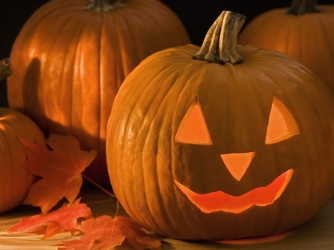
30 Oct Halloween: What a Scream!
Things that go bump on the mountain? Who in Telluride doesn’t like moguls? Things that go bump in the night? Also a familiar, though perhaps less welcomed occurrence in town, where ghosts are known to haunt some of our favorite, well, haunts: the New Sheridan Hotel; the Telluride Historical Museum, in the 19th century, the local hospital; the Silver Belle Building; the cemetery (duh). At Halloween, in town and everywhere else the notion of “”ghosting” takes on a new meaning” and “ghost” reclaims its original definition.

Scottish poet Robert Burns helped to popularize the word “Halloween” with a 1785 poem of the same name. But where did the name itself come from?
According to the Online Etymology Dictionary, “Halloween’ is actually two words smushed together. “Hallow” — or holy person — refers to the saints celebrated on All Saints’ Day, which is November 1. The “een” bit is a contraction of “eve” — or the evening before.
So basically, Halloween is just an old-fashioned way of saying “the night before All Saints’ Day” — also called Hallowmas or All Hallows’ Day.
That comes from the fact November 1 is All Saints’ Day, a Christian feast dedicated to celebrating the faithful departed, including all the saints. In Christian tradition, people start celebrating major feasts the night before they take place — take Christmas Eve, for instance…
Halloween, origin story and more;
Halloween is a holiday celebrated each year on October 31; Halloween 2023 occurs Tuesday, October 31. The tradition, however, dates back centuries.
The Celts lived 2,000 years ago in the area that is now Ireland, the United Kingdom and northern France. Their celebration began with the ancient Celtic festival of Samhain (pronounced Sow-in) when people disguised themselves as monsters of every stripe, not for sweet treats, but to save themselves from being dragged into subterranean caves that crisscrossed the region by resident demons. They would also light bonfires and wear costumes to ward off demons, ghosts and ghouls.
In the eighth century, Pope Gregory III designated November 1 as a time to honor all saints. Soon, All Saints Day incorporated some of the traditions of Samhain. The evening before became known as All Hallows Eve, and later Halloween. Over time, Halloween evolved into a day of activities like trick-or-treating, carving jack-o-lanterns, festive gatherings, donning costumes and eating treats.
Back when, November 1 marked the end of summer and the harvest and the beginning of the dark, cold winter, a time of year that was often associated with human death. Celts believed that the night before the new year, October 31, the boundary between the worlds of the living and the dead became blurred, so on the night they celebrated the aforementioned Samhain, when it was believed the dead returned to earth.
In addition to causing trouble and damaging crops, Celts thought that the presence of the otherworldly spirits made it easier for the Druids, or Celtic priests, to make predictions about the future. For a people entirely dependent on the volatile natural world, those prophecies were an important source of comfort during the long, dark winter that lay ahead.
To commemorate the event, Druids built huge sacred bonfires, where the people gathered to burn crops and animals as sacrifices to Celtic deities. When the celebration was over, when the chanting stopped, the costumed celebrants re-lit their hearth fires, (which they had extinguished earlier that evening), from the sacred bonfire to help protect them during the coming, cold season.
By 43 A.D., the Roman Empire had conquered most of the Celtic territory. In the course of the 400 years that they ruled the Celtic lands, two festivals of Roman origin were combined with Samhain.
The first was Feralia, a day in late October when the Romans traditionally commemorated the passing of the dead. The second was a day to honor Pomona, the Roman goddess of fruit and trees. The symbol of Pomona is the apple, and the incorporation of this celebration into Samhain probably explains the tradition of bobbing for apples practiced yet today on Halloween.
All Saints’ Day:
On May 13, 609 A.D., Pope Boniface IV dedicated the Pantheon in Rome in honor of all Christian martyrs, and the Catholic feast of All Martyrs Day was established in the Western church. Pope Gregory III later expanded the festival to include all saints, as well as all martyrs, and moved the observance from May 13 to November 1.
By the 9th century, the influence of Christianity had spread into Celtic lands, where it gradually blended with and supplanted older Celtic rites. In 1000 A.D., the church made November 2 All Souls’ Day in an attempt to replace the Celtic festival with a related, but church-sanctioned holiday.
All Souls’ Day was celebrated similarly to Samhain, with big bonfires, parades and dressing up in costumes as saints, angels and devils. The All Saints’ Day celebration was also called All-hallows or All-hallowmas (from Middle English Alholowmesse meaning All Saints’ Day) and the night before, the traditional night of Samhain in the Celtic religion, came to be called All-Hallows Eve and, eventually, Halloween.
Halloween Comes to America:
The celebration of Halloween was extremely limited in colonial New England because of the rigid Protestant belief systems there. Halloween was much more common in Maryland and the southern colonies…
Continue reading about Trick or Treating, Halloween parties, movies, etc. here..


Sorry, the comment form is closed at this time.